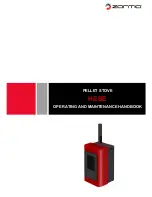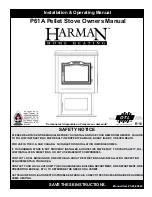ENSURE THAT YOU HAVE READ &
UNDERSTOOD THESE INSTRUCTIONS
BEFORE LIGHTING THE FIRE.
ALWAYS WEAR SUITABLE PROTECTIVE
FIRE GLOVES WHEN REFUELLING YOUR
STOVE.
SOLID FUEL BURNING
•Ensure that the ash pan is in position and the fire
doors are closed.
•Set the air wash to one quarter open position.
•Set the primary inlet to the fully open position
•Light in the normal manner with paper and
kindling, or use a fire lighter.
•If using a gas poker be sure to remove it
immediately the fire is alight.
•When the fire is well alight regulate the burning
rate by adjusting the setting on the primary air
inlet control.
•The air wash can be opened sufficiently to keep
the door glass clean
BURNING WOOD
•Set air wash to fully open position.
•Proceed as for solid fuel but note the fire will burn
up and become established more quickly.
MIXED FUELS
•As per coal but allow additional secondary air.
•The primary air inlet can be closed and burning
regulated by means of the air wash above the door.
ANTRACITE
Anthracite is more difficult to keep in for long
periods, consequently more care in setting the
controls and some familiarisation is necessary
when burning anthracite.
Use the smallest size fuel (Stovesse or Small Nuts).
Proceed as for manufactured smokeless fuel. Leave
the air inlet control open about a quarter or less.
Note: The high temperature paint acquires
durability by being "cured" during the initial
firings of the appliance will give off fumes which
are non-toxic, but which certain persons may find
have an unpleasant or irritant effect. Ensure that
the area is well ventilated during this time.
OVERNIGHT BURNING
The appliance will burn overnight provided:
•Sufficient fuel is placed in the firebox.
•The controls are set correctly.
•Excess draught is not present in the chimney.
•Close the door.
•If the fire goes out with unburnt fuel left in the
firebox increase the air opening slightly, and vice
versa.
In the morning
Open the air control fully until embers begin to
glow brightly and place pieces of fuel on the fire
until it is well established.
WARNING:
When wood is burnt slowly in a
closed appliance it produces moisture and tar,
which will create condensation and deposits in the
chimney. This effect can be minimised by burning
hard for a short period, about 20 minutes, twice a day.
It is usually convenient to do this morning and night.
Note: To avoid chimney problems your fire should
not be burnt slowly for longer than 12 hours
without a period of fast burning.
WARNING: Properly installed, with a suitable
flue and chimney and operated and maintained
this appliance will not emit fumes into the
dwelling. Occasional fumes from the de-ashing
and re-fuelling may occur. However, persistent
fume emission is potentially dangerous and must
be investigated dy a Hetas registered installer.
Stop using the appliance if you smell fumes or
see smoke escaping.
If fume emission does persist, the following
immediate actions should be taken.
•Open doors and windows to ventilate room.
•Let the fire die or extinguish and safely
dispose of fuel from the appliance.
•Check for flue or chimney blockage, and
clean if required.
Seek expert advice from your HETAS registered
installer. Do not attempt to re-light the fire until the
cause of the fume emission has been identified and
corrected.
12
Beacon Multifuel Stoves
OPERATING INSTRUCTIONS


















